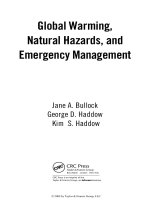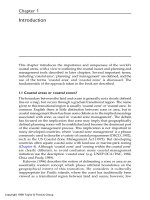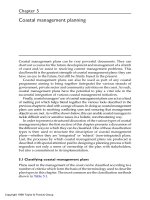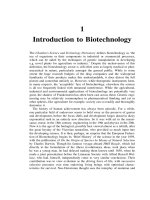Corporate Environmental Management - Chapter 1 docx
Bạn đang xem bản rút gọn của tài liệu. Xem và tải ngay bản đầy đủ của tài liệu tại đây (695.83 KB, 18 trang )
CRC Press is an imprint of the
Taylor & Francis Group, an informa business
Boca Raton London New York
CORPORATE
ENVIRONMENTAL
MANAGEMENT
JOHN DARABARIS, P.E., C.P.A.
55461_C000.fm Page iii Friday, June 29, 2007 4:26 PM
© 2008 by Taylor & Francis Group, LLC
CRC Press
Taylor & Francis Group
6000 Broken Sound Parkway NW, Suite 300
Boca Raton, FL 33487-2742
© 2008 by Taylor & Francis Group, LLC
CRC Press is an imprint of Taylor & Francis Group, an Informa business
No claim to original U.S. Government works
Printed in the United States of America on acid-free paper
10 9 8 7 6 5 4 3 2 1
International Standard Book Number-13: 978-1-4200-5546-7 (Hardcover)
is book contains information obtained from authentic and highly regarded sources. Reprinted
material is quoted with permission, and sources are indicated. A wide variety of references are
listed. Reasonable efforts have been made to publish reliable data and information, but the author
and the publisher cannot assume responsibility for the validity of all materials or for the conse-
quences of their use.
No part of this book may be reprinted, reproduced, transmitted, or utilized in any form by any
electronic, mechanical, or other means, now known or hereafter invented, including photocopying,
microfilming, and recording, or in any information storage or retrieval system, without written
permission from the publishers.
For permission to photocopy or use material electronically from this work, please access www.
copyright.com ( or contact the Copyright Clearance Center, Inc. (CCC)
222 Rosewood Drive, Danvers, MA 01923, 978-750-8400. CCC is a not-for-profit organization that
provides licenses and registration for a variety of users. For organizations that have been granted a
photocopy license by the CCC, a separate system of payment has been arranged.
Trademark Notice: Product or corporate names may be trademarks or registered trademarks, and
are used only for identification and explanation without intent to infringe.
Library of Congress Cataloging-in-Publication Data
Darabaris, John.
Corporate environmental management / John Darabaris.
p. cm.
Includes bibliographical references and index.
ISBN 978-1-4200-5546-7 (alk. paper)
1. Environmental management Industrial applications. 2. Environmental
risk assessment Industrial applications. 3. Social responsibility of
business Environmental aspects. 4. Industrial management Environmental
aspects. I. Title.
GE300.D37 2008
658.4’083 dc22 2007016722
Visit the Taylor & Francis Web site at
and the CRC Press Web site at
55461_C000.fm Page iv Friday, June 29, 2007 4:26 PM
© 2008 by Taylor & Francis Group, LLC
v
Table of Contents
Preface ix
About the Author xi
List of Illustrations xiii
1
Introduction 1
Reference 7
2
Environmental Management Assessment 9
3
Lines of Inquiry 13
4
Assessment Model and Analytical Framework 17
Assessment Model 17
Analytical Framework 19
Program vs. Project Management 20
Environmental Risk Management 22
5
Internal Survey 27
Corporate Headquarters 27
Operations 29
6
Corporate Commitment 31
Senior Management Commitment 31
Corporate Environmental Policy 33
Responsible Care 34
The CERES Principles 35
GEMI and the ICC Charter 35
United Nations Environment Programmes’ Financial Institutions
Initiative on the Environment 36
Environmental Banking Association 36
World Business Council for Sustainable Development 36
ISO 14000 37
Performance Track Corporate Leaders 40
Strategic Environmental Planning 40
References 42
7
Communication 43
External Communication/Public Relations 43
55461_C000.fm Page v Friday, June 29, 2007 4:26 PM
© 2008 by Taylor & Francis Group, LLC
vi
CORPORATE ENVIRONMENTAL MANAGEMENT
Internal Communication 46
Issue Management 48
8
Functional Implementation 51
Organization and Staffing 51
Internal Integration 52
Operational Systems 53
Pollution Prevention Opportunities 55
Environmental Risk Management 60
Waste Minimization Programs 61
The Emission Reduction Program 63
9
Measurement Systems 65
Audit Program 65
Site Tours 68
Root Cause Analysis 69
Environmental Management Information System (MIS) 70
Environmental Cost Management 72
Environmental Asset Management 75
Environmental Financial Management 77
Conventional Commercial Loan 79
Supplier Financing 79
Commercial Paper 80
Bond Financing 80
Private Placement Debt 81
Environmental Capital Equipment Leasing 81
Environmental Related Preferred Stock 82
Master Limited Partnerships 82
Research and Development 82
References 86
10
Benchmark Survey 87
Environmental Management-Based Benchmarking Survey Approach 89
Technical-Based Benchmarking Survey Approach 91
References 96
11
External Survey 99
External Scan 99
Assessing Global Impacts—Sustainable Development 99
Project Life Cycle Analysis 103
Activist Group Alliances 105
Independent Technology Scan 107
12
Natural Resource Damage Assessment—Proactive Strategies 109
Early Recognition of Contamination Stage 113
Agreement or Settlement Stage 115
Cleanup Stage 115
Pursuit of a PRP Claim Stage 115
References 115
55461_C000.fm Page vi Friday, June 29, 2007 4:26 PM
© 2008 by Taylor & Francis Group, LLC
vii
Table of Contents
13
Environmental Risk Assessment Issues 117
General Discussion 117
Health Assessments 117
Ecological Risk Assessment 120
Population Risk Analysis 122
References 123
14
Emergency Response Analysis 125
Contingency Plans 126
Up-the-Stack Emergencies 127
General Emergency Management Concepts 130
References 134
15
Corporate Health and Safety System 135
Establishing Hazard and Safety Control Measures 136
Inorganic Chemicals 137
Organic Compounds 138
Operational Chemicals/Hazard Communication Program 138
Personal Protective Equipment 139
Respiratory Protection 139
Levels of Protection 140
Monitoring and Medical Surveillance 143
Site Control of Work Zones 144
Exclusion Zone (EZ) 144
References 144
16
Environmental Risk Management at Banking Institutions 147
Practices for the Commercial Banking Community 149
EPA Lender Liability Rule 151
Post-Commitment Practices for Debt Transactions 152
Practices for the Equity Banking Community 154
Integrating Environmental and Financial Performance 157
References 164
17
Global Warming 167
Existing Market and Potential Revenue 168
Brokers 169
Global Climate Profile 169
Global Climate Summary 172
References 174
18
Assessment of International Trends 175
OECD/EIRIS Study Results 175
Survey on the State of Global Environmental and Social Reporting 186
Emerging China and India Environmental Issues 187
Kyoto Protocol Debates 188
State of the U.S. Environmental Policies 189
55461_C000.fm Page vii Friday, June 29, 2007 4:26 PM
© 2008 by Taylor & Francis Group, LLC
“Greenwash” versus “Green Machine” Debate 189
ExxonMobil 190
Wal-Mart 190
References 190
19
Summary 193
References 196
55461_C000.fm Page viii Friday, June 29, 2007 4:26 PM
© 2008 by Taylor & Francis Group, LLC
ix
Preface
The goal of corporate environmental management is threefold:
• To provide a basis for the independent assessment of environmental
management that marries the various standardized approaches for
measuring components (e.g., environmental audits for facilities,
ISO 14000 compliance) with the larger and more sophisticated goals
of overall corporate management objectives;
• To provide summary inputs regarding various global environmental
management initiatives and developments that may be of interest
to the target audience (with full recognition that this is a moving
target); and
• To provide technical and management insights and suggestions to
aid environmental management professionals and their corporate
management structure in their development and implementation of
initiatives, as well as providing interested investment and stake-
holder communities a basis for independent evaluation.
The target audience is also threefold:
• To provide senior management and boards of directors a concise,
independent approach to assessing their respective environmental
management programs from a senior executive perspective;
• To provide the investment community with an independent perspec-
tive for evaluating corporate environmental management perfor-
mance of their portfolio (and prospective portfolio) as well as
updates on the emerging environmental stance within the invest-
ment community and its regulatory bodies (e.g., SEC); and finally,
• To provide the environmental management community itself with
suggestions and implementation strategies for basic issues such as
health and safety, clean air, clean water, CERCLA, and NRDA, as well
as emerging issues such as risk management, conservation science,
and sustainable development reporting.
Last, corporate environmental management has a fourth goal and target
audience—to provide a sound crossover primer for the academic commu-
nity, providing a science and regulatory perspective to the MBA community,
and a management perspective to the environmental science/engineering
graduate community.
55461_C000.fm Page ix Friday, June 29, 2007 4:26 PM
© 2008 by Taylor & Francis Group, LLC
xi
About the Author
John Darabaris
, currently in a management capacity, was formerly a
division vice president with Kearney/Centaur, where he conducted numer-
ous corporate environmental management assessments and benchmarking
studies as well as “best practice” studies. He is an experienced environmen-
tal management professional knowledgeable in both environmental man-
agement and regulatory strategy as related to complex, sophisticated,
industry environmental activities. Possessing both a professional engineer
(PE) license and a non-practicing certified public accountant (CPA) certifi-
cate, he marries both engineering and management perspectives to the
impacts of corporate environmental management and related regulatory
strategy development.
With a background that combines graduate degrees in geologic engi-
neering (MS, University of Missouri at Rolla) and finance (MBA, Columbia
University, New York), Darabaris provides unique insights into the
breadth of technical, regulatory, and management issues that corporate
environmental management teams face in today’s complex environmental
corrective-action management world.
In recognition of his achievements, Darabaris was awarded an honorary
professional development degree from the University of Missouri at Rolla
and a commendation from the U.S. Army Corps of Engineers’ Omaha office.
This is Darabaris’ second book. His first,
Macroengineering: An Environ-
mental Management Restoration Management Process
(CRC Press, 2006), is
currently on the market and has sold worldwide in over 20 countries and
over a dozen universities.
55461_C000.fm Page xi Friday, June 29, 2007 4:26 PM
© 2008 by Taylor & Francis Group, LLC
xiii
List of Illustrations
Exhibit 1. New environmental problems and the environmental competition
of companies.
Exhibit 2. Evolution and assessment of environmental management.
Exhibit 3. Business consequences of the “efficient compliance” approach.
Exhibit 4. Few environmental restoration chains are effectively integrated.
Exhibit 5. Integrated environmental management programs.
Exhibit 6. Components of an SC&A environmental management assessment.
Exhibit 7. Elements of an external survey.
Exhibit 8. Environmental management assessments: Stages of Excellence.
Exhibit 9. Principal analytical criteria.
Exhibit 10. Program versus project management analysis.
Exhibit 11. Interwoven risk perspectives.
Exhibit 12. Perceived risk reflects public attitude.
Exhibit 13. Environmental management risk review process.
Exhibit 14. Environmental management regulatory model.
Exhibit 15. Positioning the environmental management role.
Exhibit 16. Internal survey, examples of breadth versus depth.
Exhibit 17. Risk management “audit” versus “risk” management cultures.
Exhibit 18. Strategic environmental planning model.
Exhibit 19. External communication links.
Exhibit 20. Straw model communications plan matrix.
Exhibit 21. Internal communication links.
Exhibit 22. Instituting ongoing feedback and learning.
Exhibit 23. Examples of functional implementation with other corporate groups.
Exhibit 24. Disruptive environmental technologies: A need for leadership.
Exhibit 25. Examples of process or equipment modifications enhancements.
Exhibit 26. Examples of potential maintenance enhancements.
Exhibit 27. Examples of potential waste segregation and separation
enhancements.
Exhibit 28. Examples of recycling and potential material substitution
enhancements.
Exhibit 29. Pathways to environmental risk management.
Exhibit 30. Functional implementation criteria model.
Exhibit 31. Metrics Development Wheel.
Exhibit 32. Examples of potential environmental management information
system (MIS) elements.
Exhibit 33. The EHS cost pyramid.
Exhibit 34. The Ricoh approach to environmental accounting.
Exhibit 35. Strategic management of EHS investments.
Exhibit 36. Example of an environmental asset value chain.
Exhibit 37. A capital value approach to establishing value of performance.
55461_C000.fm Page xiii Friday, June 29, 2007 4:26 PM
© 2008 by Taylor & Francis Group, LLC
xiv
CORPORATE ENVIRONMENTAL MANAGEMENT
Exhibit 38. A risk-based decision approach to valuing performance assets.
Exhibit 39. Using stakeholder satisfaction to value excitement assets.
Exhibit 40. Establishing the competitive position of assets.
Exhibit 41. A portfolio approach to valuing EHS assets.
Exhibit 42. EcoVALUE’21™ variables.
Exhibit 43. Benchmarking environmental practice and performance.
Exhibit 44. Example of process for benchmarking environmental management
structure and effectiveness.
Exhibit 45. Difference between internal and external views gained from
benchmarking.
Exhibit 46. Criteria for environmental management success.
Exhibit 47. Stages of the environmental management success model.
Exhibit 48. Performance parameter examples.
Exhibit 49. Sample format of a benchmarking questionnaire layout.
Exhibit 50. Sample of a display plot format.
Exhibit 51. List of the EPA’s Office of Compliance Industry Sector Notebooks.
Exhibit 52. 1993 Pollutant Releases (short tons/year), from the Petroleum
Refining Industry Sector Notebook, September 1995.
Exhibit 53. Summary of 1993 Toxics Release Inventory (TRI) data: Releases and
transfers by industry, from the Petroleum Refinery Industry Sector Notebooks,
September 1995.
Exhibit 54. 1993 Toxics Release Inventory (TRI) data for selected industries
(Source: Petroleum Refinery Industry Sector Notebooks, September 1995).
Exhibit 55. Potential external scan participants.
Exhibit 56. Assessing global impacts.
Exhibit 57. Forces driving sustainable development.
Exhibit 58. Scenario for building the business environment.
Exhibit 59. Environmental management audit technology success criteria.
Exhibit 60. Framework for natural resource damage (NRD) claims.
Exhibit 61. Natural resource damage (NRD) assessment process (as established
by 43 CFR Part II).
Exhibit 62. Prototypical examples of natural resource damage (NRD) claim
expansion impact.
Exhibit 63. Types of environmental restoration sites.
Exhibit 64. Ten technical defense tips: Areas of potentially “unrealistic
expectations” on which to focus.
Exhibit 65. Dose response curve (dose, arbitrary units, logarithmic scale).
Routes of entry: inhalation, ingestion, absorption, injection.
Exhibit 66. UEL/LEL example for gasoline.
Exhibit 67. Levels of protection: Level A, Level B, Level C, and Level D.
Exhibit 68. Environmental strategies: A corporate view.
Exhibit 69. Global climate change lexicon.
Exhibit 70. Six Kyoto greenhouse gases (GHG).
Exhibit 71. Share of enterprises that publish environmental policy statements.
Exhibit 72. Companies in FTSE All-World Developed Index, by nationality and
sector.
Exhibit 73. Contents of environmental policy statements, all sectors.
Exhibit 74. Signatories to Voluntary Initiatives.
Exhibit 75. Share of enterprises that have implemented environmental policy
statements.
Exhibit 76. Share of enterprises that undertake environmental performance
reports.
Exhibit 77. Nature of companies’ environmental performance reports
(percentage share of companies that issue EPR/EPS).
55461_C000.fm Page xiv Friday, June 29, 2007 4:26 PM
© 2008 by Taylor & Francis Group, LLC
xv
List of Illustrations
Exhibit 78. Evidence of the presence of an occupational health and safety
system (percentage share, by country or region).
Exhibit 79. Different perspectives of environmental management performance.
Exhibit 80. Sustainable development.
Exhibit 81. Understanding sustainable development.
Exhibit 82. Recognize the emotional cycle for environmental management
change.
55461_C000.fm Page xv Friday, June 29, 2007 4:26 PM
© 2008 by Taylor & Francis Group, LLC
1
Chapter 1
Introduction
There is a new era of global environmental factors that needs to be
addressed via sound Corporate Environmental Management. Environmental
problems are a key area of concern for the global community in the new
21st century. A sustainable global community is emerging that is geared
toward preserving limited resources and the natural ecology, but to do so
requires resource conservation and the reduction of environmental pollu-
tion loads across all human activities.
This text focuses on the emerging relationship between corporate
management and the environment as a new era arrives on the scene, where
environmental factors increasingly play a key role in corporate competi-
tion and generate a need for environmental assessments of companies. In
this new era, the view of environmental problems has undergone a shift
from localized industrial pollution to a broader realization of their collec-
tive impact on global environmental problems.
The industrial pollution problems that afflicted industrial nations were
recognized in the 1960s. In most industrial nations, strong campaigns were
undertaken to identify the source of pollution and the damage caused.
In many cases, the source and dangers could be traced to specific busi-
nesses and specific actions. Programs were swiftly implemented that satis-
factorily dealt with the situation via “end-of-pipe” regulations that restricted
emissions of air and water pollutants from factories. In the process, industri-
alized nations have increasingly shifted their emphasis from direct end-of-
pipe regulations on industrial pollution to more market-oriented measures
that encourage creative solutions to reducing environmental loads and costs
(short-term and long-term).
End-of-pipe regulations
required companies to comply with emission
standards for gases, water, and noise emanating from production sites.
Companies complied with the legal emission standards by installing treat-
ment facilities for gas and water emissions. However, the controls were
viewed as being problematic because they restricted operations and
increased costs. As such, pollution controls did little to encourage corpo-
rate competition to resolve environmental problems on a grander scale.
However, in the 1980s with the recognition of the dire long-term impacts
of global warming, acid rain, and the depletion of rain forests, environmental
problems became global in scale. These newly recognized problems were
55461_C001.fm Page 1 Tuesday, June 5, 2007 10:15 AM
© 2008 by Taylor & Francis Group, LLC
2
CORPORATE ENVIRONMENTAL MANAGEMENT
not derived by end-of-pipe industrial pollution as much as from environ-
mental loads being generated in the daily activities of businesses and indi-
viduals that when assessed individually seem small but in the aggregate
have a huge regional and even global impact.
This new, more market-oriented regulatory approach to environmental
problems is aimed toward encouraging companies to find creative solutions
to their global impact by reducing carbon dioxide and other greenhouse gas
emissions, curtailing household and corporate waste generation while
actively promoting recycling, and introducing the PRTR (Pollutant Release
and Transfer Register) system for reporting and registering potentially
harmful emissions and transport of waste that attacks the problem on a
large scale.
As part of this effort, green procurement initiatives were enacted that
promoted purchases of environmentally friendly products. Also basic laws
were developed to promote a recycling-oriented society and regulate the
tracking of emission audits. In its totality, these efforts aimed at curbing
emissions on the regional and global scale. These laws form the legal
framework for waste management and recycling.
Another part of this new regulatory approach has been a growing trend to
emphasize environmental considerations in the previously untouched prod-
uct and service markets. Through packaging and recycling, consumers
began sorting discarded packages into recycling categories (e.g., glass
bottles, PET bottles, steel and aluminum cans, and paper packs). This sort-
ing allowed municipal waste collectors to collect these packages separately
and business operators the opportunity to retrieve and re-use them. A
similar approach emerged regarding the recycling of industrial waste. The
approach allowed initial recycling costs to be borne by businesses through
prudent pricing passed to a degree to consumers.
Through laws and reorganized handling procedures, the cost of recy-
cling packages was reduced to the point where it no longer internalized the
societal costs and, as a side benefit, companies have begun adopting a long-
term effort toward converting to lighter, more simple packages and reusable
materials. Appliance recycling efforts (e.g., air conditioners, televisions,
refrigerators, and washers) allow consumers to return discarded appliances
to retailers, who then deliver the products to their respective manufacturers.
Consumers must pay the recycling costs, in this case at the time of return.
The fee is to help suppress excessive consumer consumption.
As time has passed, it has become increasingly clear that companies that
adopt the most efficient recycling method enhance their price competitive-
ness, whereas those who recycle inefficiently suffer. Herein is found a
fundamental enhancement from the end-of-pipe pollution regulations in
the 1970s. The latter focused on environmental refund costs to comply
55461_C001.fm Page 2 Tuesday, June 5, 2007 10:15 AM
© 2008 by Taylor & Francis Group, LLC
3
Introduction
with emission standards. Under the market approach, companies are
encouraged to invest in ways that will differentiate their products and
enhance competitiveness.
Energy conservation efforts invoke even tougher market principles
to encourage companies to take creative steps in reducing energy con-
sumption (and hence, carbon dioxide emissions). Key features include
the setting of energy conservation standards for designated machines
(automobiles, home appliances, and office automation equipment)
base. Competition is increased, driving each company’s products to meet
the standard set by the most energy-efficient product on the market.
Companies that fail to improve product performance are subject to
increasing market-driven as well as regulatory-driven forces. Those
companies who cannot (or will not) compete are ultimately forced to
withdraw their products from the market. By compelling companies to
meet the highest energy-saving standards on the market, the global
legal market affects not only the competitiveness of products but
strikes at the heart of overall corporate survival.
Pollutant release and transfer laws emerged in the industrial community
worldwide, requiring companies to measure and report emissions for
specified chemical substances released into the air, water, and soil, as well
as wastes transferred offsite for treatment and disposal. The impact of this
tracking is that companies are increasingly performing risk management of
chemical substances—the cost of which is often quite substantial—and
when recognized, induce efforts to reduce, mitigate, or eliminate.
The best policy is to avoid using any harmful or hard-to-manage chemi-
cals but often this is unrealistic. Regardless, a system should be in place to
minimize the generation of harmful chemical waste via manufacturing
methods and processes, raw material selection, and product compositions.
This improvement will have significant implications not only in preventing
direct contamination risk but in avoiding the risk of marketplace rejection
or exclusion from customers and consequent competitive disadvantage.
Both the manufacturing and retail communities are increasingly recog-
nizing the market power of green purchasing.
Green purchasing
refers to the
activity of purchasing products and services with the smallest environmental
impact, thereby encouraging companies to become more environmentally
responsive. The approach is based on the idea that “green consumers” use
their purchasing power in the consumer market to reward businesses that
actively engage in environmental issues and to prompt reluctant businesses
to do more.
However, whereas there is increasing evidence of consumers’ aware-
ness of green purchasing, it has been difficult to establish the degree to
which green purchasing is having an impact at the consumer level. There
55461_C001.fm Page 3 Tuesday, June 5, 2007 10:15 AM
© 2008 by Taylor & Francis Group, LLC
4
CORPORATE ENVIRONMENTAL MANAGEMENT
is a surprisingly strong response to purchasing within corporate commit-
ments that are trying to establish “green credentials.” To that end, the
green purchasing movement has been rapidly growing among businesses,
organizations, and government offices, thereby effectively promoting
green markets. There is hope that this will increasingly shift market
demand toward green products, thereby leading to lower prices. More
progress has occurred as cost savings are increasingly identified through
these “green procurement” efforts. Large assembly and processing compa-
nies are increasingly procuring raw materials and components meeting
their environmental specifications. Markets are clearly becoming more
selective regarding environmental factors. In the future, even more emphasis
is expected in business-to-business green transactions.
While the environmental laws impose significant cost burdens on compa-
nies, they, along with market factors, provide an impetus for companies to
respond with creative solutions and business decisions to environmental
problems (see Exhibit 1). To that end, under the energy environmental
market-oriented approach, corporate survival will rest on the success of
business strategies (environmental strategies) to enhance price competi-
tiveness and business performance.
In the manufacturing sector, reducing environmental loads in the vari-
ous stages of manufacturing, use, and disposal of products will require
Exhibit 1. New environmental problems and the environmental competition
of companies.
Qualitative & structural change in environmental problems
Shift to market-oriented
environmental regulations
↔
Green markets
Emergence of environmental criteria
in competition and assessment
→
Start of environmental competition
Inevitable shift to environmental
management
→
Increase in companies championing
environmental management
Increased need of stakeholders for company assessments
Need for company assessments focused on environment
55461_C001.fm Page 4 Tuesday, June 5, 2007 10:15 AM
© 2008 by Taylor & Francis Group, LLC
5
Introduction
ongoing review of raw material and component selection and procure-
ment, production processes, distribution channels, packaging, and volume
and ease of dismantling and recycling wastes. This fosters a “design for the
environment” (DfE) approach based on the product life cycle assessment
(LCA) of environmental loads. In turn, life cycle costing (LCC) that results
from these design efforts will impact price competitiveness. This adds up
to companies that will clearly be differentiated by the strategies they
adopt. Such re-engineering cannot be achieved with a “follow-the-leader,”
conformist mentality, such that the environmental re-engineering has
spawned a new competitive condition.
Therefore, as green purchasing and procurement move ahead, the market
forces are increasingly pressuring companies to develop more environmen-
tally compatible products and services. In the past, companies pursued
products based on price, performance, and quality standards. In the
future, the additional competitive condition of the environment will force
companies to also demonstrate “environmental rationality.”
As a result, companies are reducing environmental loads across all activi-
ties and developing methods to measure and verify their green energy. Still,
the objective assessment of corporate environmental performance is diffi-
cult both internally and externally. To that end, an effort is made here to lay
out a framework and identify environmental management assessment and
reporting standards. Thus, the environment has emerged simultaneously as
a new assessment standard as well as a competitive condition.
Environmental considerations historically have little effect in determin-
ing a company’s competitive position, nor have companies been system-
atically scrutinized with environmental management assessments. But
the rules of competition are shifting to include environmental rationality.
Companies are increasingly confronting a new era of environmental-based
competition, where to an increasing degree business success is tied to
competitiveness in environmental factors.
Until recently, Corporate Environmental Management has been largely
reactive in nature, reluctantly complying with environmental controls
while being monitored by regulatory and stakeholder groups. However, the
tidal shift toward green markets is fostering a more proactive stance on
environmental management that anticipates new regulations, market
trends, and environmental competition factors.
Environmental management
in the classic sense refers to the development
and execution of environmental strategies to assure sustained corporate
growth. The crux is the implementation of an environmental management
system (EMS) based on seven principles. Of these, corporate commitment
is the key; without it, no Corporate Environmental Management program
can succeed. But how to measure it? And how does one measure the overall
55461_C001.fm Page 5 Tuesday, June 5, 2007 10:15 AM
© 2008 by Taylor & Francis Group, LLC
6
CORPORATE ENVIRONMENTAL MANAGEMENT
concept of Corporate Environmental Management? There are seven prin-
ciples with which one can begin:
1. Commitment of top management
2. Development of an environmental plan and organizational structure
3. Company-wide participation of all employees
4. Efficient use of management resources
5. Sustained effort to reduce waste generation
6. Detection and minimization of environmental risks
7. Disclosure to stakeholders and investment community
A growing number of companies are establishing environmental manage-
ment capabilities via environmental performance reporting, sustainable
development reporting, and since the mid-1990s, ISO 14001 certification.
Companies have been even releasing environmental audits and manage-
ment assessments, but there is a bevy of parties interested in seeing such
assessments formally developed.
Besides consumers, business customers, and suppliers, companies are
surrounded by a variety of stakeholders—groups with an interest in a
company’s activities such as shareholders, banks, investors, local residents,
and government agencies. As the severity of environmental problems has
become clearer, stakeholders have increasingly demanded that companies
be assessed on their environmental risks and merits that potentially impact
their investment.
Just as interested are financial institutions, most notably when making
loan or investment decisions. There is a strong movement to increasingly
consider a company’s environmental stance and environmental risks to a
much higher degree than in the past, when environmental factors were
excluded from consideration because of difficulties in determining their
effect on a company’s financial performance. But it is now understood that
corporate survival has an environmental dimension, so whereas it is
unlikely that poor environmental management will result in immediate
business failure, there is little doubt that in the future competence in
environmental management will become an increasingly important factor
in price competitiveness, financing, and business performance. In short,
corporate survival will rest in part on environmental factors, and poor
environmental decisions and unacceptable environmental risk could prove
damaging. Asset managers are interpreting more broadly the prudent man
rule—minimize risk, maximize returns, and preserve assets—to
encompass the environmental performance/risk issue.
Finally, international investment companies are now selling “eco-funds”
(environmentally responsible stock investment trust funds). These funds
are groundbreaking financial products in two respects: for confronting
the issue of environmental responsibility and for investing selectively in
55461_C001.fm Page 6 Tuesday, June 5, 2007 10:15 AM
© 2008 by Taylor & Francis Group, LLC
7
Introduction
companies based on environmental criteria. Exhibit 2 lays out some of the
forces generating the urgent need for Corporate Environmental Manage-
ment assessment.
Reference
Kawamura, Masahiko.
NLI Research No. 145, 2000
(NLI Research Institute, 2000).
Exhibit 2. Evolution and assessment of environmental management.
Introduction of market approach to environmental problems
Improvements in environmental management
Green markets Stakeholder demand for assessments
Response of financial markets
Shift to market-oriented regulations
Environmental
competition
Environmental
strategy
Environmental reports
Environmental accounting
ISO 14001 certification
Introduction
of EMS
Problem awareness
1990s 2000
Time
Environmental
assessments of
companies
55461_C001.fm Page 7 Tuesday, June 5, 2007 10:15 AM
© 2008 by Taylor & Francis Group, LLC









